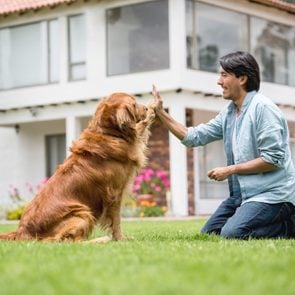11 Best Emotional Support Dogs
Updated: Jul. 06, 2023
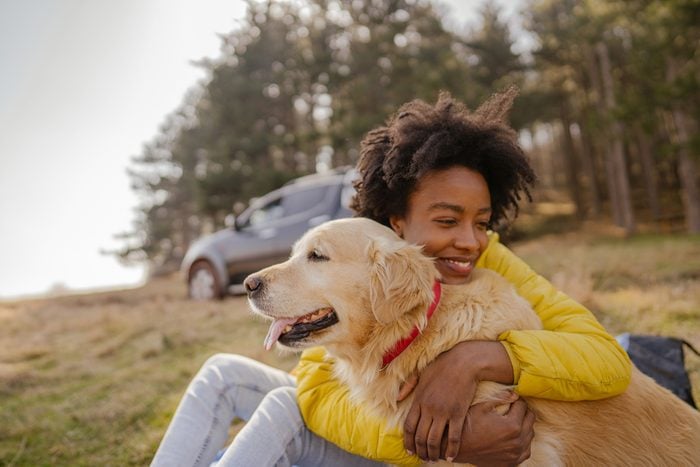
These dog breeds check off all the boxes for the ultimate emotional support dog—they're cute and cuddly and, most importantly, totally devoted to your comfort and happiness.
What is an emotional support dog?
Emotional support animals (ESA) provide comfort and attention and can be any species from the animal kingdom. We’re most familiar with dogs as being the primary animal to fill this role. When people care for their dog, whether feeding, grooming, or walking, it creates a sense of purpose and can distract attention away from the things causing anxiety and other mental health issues. And while dogs can’t offer advice, they are excellent listeners (or at least appear to be)—and that’s a tremendous help for those who want to talk it out without being judged. Whether they’re a cute small dog breed or a lovable large one, they all add up to the most loyal and affectionate dog breeds you could ever ask for.
Service dogs vs. emotional support dogs
The waters can get kind of muddy when determining the difference between a service and emotional support dog. The American Disabilities Act states, “A service animal means any dog that is individually trained to do work or perform tasks for the benefit of an individual with a disability, including a physical, sensory, psychiatric, intellectual, or other mental disability.”
Service dogs are trained to do specific tasks for the person with a disability. For example, a seeing eye dog helps people who are blind or have visual impairments travel safely, and a psychiatric service dog helps people with psychiatric episodes. The dog can remind a person to take their medicine or turn on lights and do safety checks for people with post-traumatic stress disorder. A service dog is virtually allowed anywhere the public is permitted.
Emotional support dogs and therapy dogs are not considered service animals under ADA because they don’t have special training to perform specific tasks that assist people with disabilities. Emotional support dogs provide their human with love and companionship. By definition, they aren’t considered pets, though they live with their human and typically live a pet’s life. Therapy dogs are usually seen in hospitals and nursing rooms. They offer a pleasant distraction by lavishing affection and cuddling service to patients and clients who could use some encouragement. When the dogs are done “working,” they go home with their handler and are treated as pets.
Can emotional support dogs really make a difference?
Dog lovers inherently understand that dogs make people feel better. When we pet a dog, it brings a smile to our faces, our blood pressure goes down, and stress and anxiety fade into the background even during a chance encounter.
Even so, it’s validating to know that some studies show companion dogs can decrease anxiety and depression and improve overall mental health. A 2018 review published in BMC Psychiatry included 17 studies that featured measurable evidence relating to the ups and downs of pet ownership, how people connect with pets, the multiple ways companion animals help mental health conditions, and the psychological impact of losing a companion animal. In a nutshell, the review found pets provide benefits to those with mental health conditions.
A more recent study conducted at the University of Toledo showed people who adopted companion animals experienced reduce depression, anxiety, and loneliness. Though more research is needed, so far, studies point to companion animals as being a beneficial partner in human health and well-being.
What makes a good emotional support dog breed?
“The most important aspect to consider is the connection between the dog and the owner,” says Angela Logsdon-Hoover, ABCDT, a certified dog trainer and canine behaviorist, and regional technician director with VCA Animal Hospitals.
In her experience, the person’s current dog is the best fit for the person who needs an ESA. “The dog already has a strong bond and the dog likely already naturally picks up on the owner’s stress response to triggers and can offer calm, comfort, and security,” says Logsdon-Hoover. If a person doesn’t have a dog, the connection factor is equally important when looking for an emotional support dog. Additionally, the dog should already have good doggy manners at home, in public, and with other people and dogs. If not, you can learn together with basic obedience training.
Ideally, emotional support dogs are tuned into their human and react accordingly to what their person says or does, whether that’s with a celebratory dance, cuddling on the couch, or crying when they’re having a tough time.
Emotional support dog breeds
Calm dog breeds with easy-going personalities and loyal dog breeds who will never leave your side are naturally suited for emotional support dogs. With that in mind, our experts shared some of their favorites. Note that this is by no means an exclusive list. Any breed—or mixed breed for that matter, has the potential to be an excellent emotional support dog.
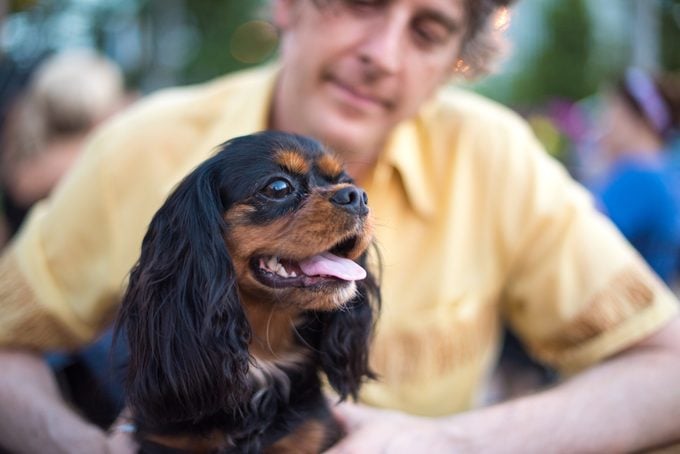
1. Cavalier King Charles spaniel
Cavaliers were initially created to be companions dogs, so their genetics run deep as warm-hearted comforters. They are undeniably cute, well-mannered, and petite in size, making them great apartment dogs. “For people who want the companionship of their emotional support dog in a metropolitan area, the Cavalier King Charles spaniel is a good pick for a canine friend,” says Stacy Chocznski Johnson, DVM, and veterinary expert for Pumpkin Pet Insurance. They love adults, children, and animals and are “irresistible to pet on a city street,” says Dr. Chocznki Johnson. They could act as an ice breaker and help socially awkward situations and reassure or console you when you’re back at home.
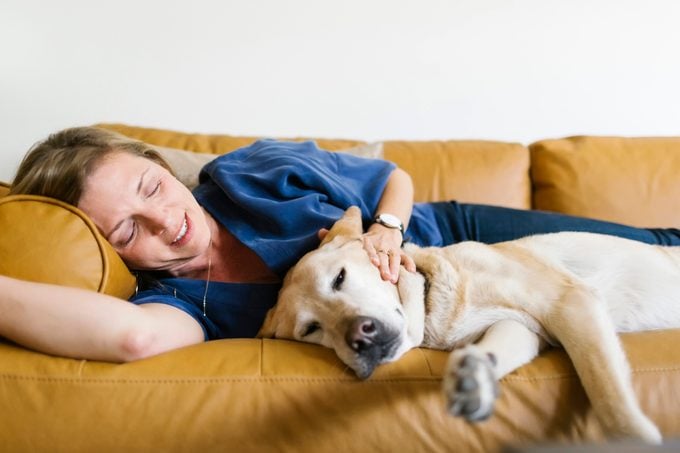
2. Labrador retriever
As one of the most popular dog breeds in the country, it’s no shocker the loveable Labrador retriever is also a top-notch emotional support dog. As temperament goes, they’re happy, laid-back, and nothing seems to bother them much. They are trustworthy, dependable, and always there to lick your face—or your ice cream cone. “This breed is super food motivated,” says Nicole Ellis, a certified professional dog trainer, and Pet Lifestyle Expert with Rover. Because of this, it’s easy to train them and teach them helpful tasks, such as laying beside you, resting their head on you, or providing deep pressure therapy, which is used to help reduce anxiety. It can be brought about by hugging, weighted blankets, and yes, by brushing a dog or a dog laying across your body, Ellis explains.
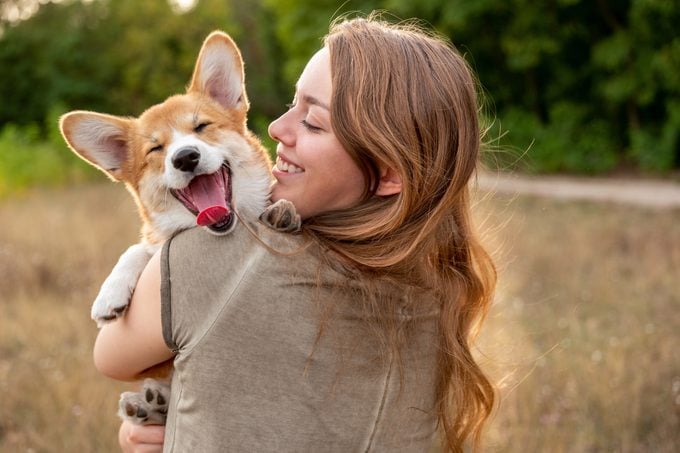
3. Corgi
“Corgis are happy, playful, easy-going dogs, making them a great choice for an emotional support dog,” says Dr. Chocznski Johnson. “Watching a Corgi play can bring entertainment and joy to anyone. Seeing them zip around with their short legs and rotund hind ends can easily bring a smile to your face.” And you can have your pick of two types of Corgis—the Cardigan Welsh Corgi or the Pembroke Welsh Corgi. The Cardigan is slightly larger and has a fox-like bushy tail and the Pembroke, a docked tail. They do share similar temperaments—fun-loving, playful, clever, and affectionate with a touch of boldness. After all, they are classified as herding dogs and have a strong instinct to protect their human. If you’re looking for a pup that stays small forever, read up on these adorable toy dog breeds.
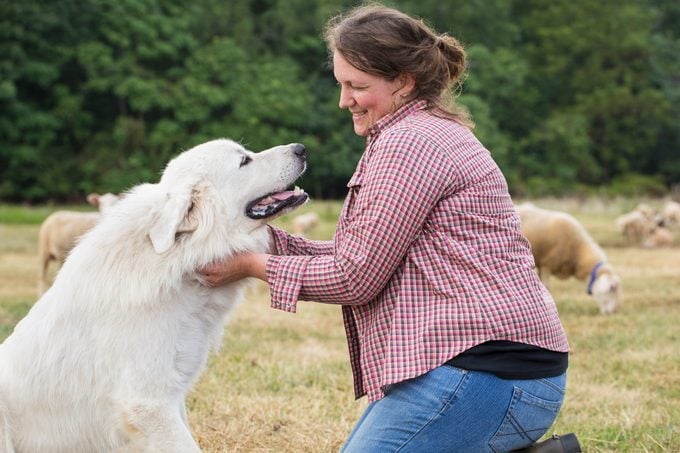
4. The Great Pyrenees
“If you find stress relief in repetitive motions like hair brushing, this is the perfect breed, as they require a significant amount of grooming for their thick luxurious coat,” says Dr. Choczynski Johnson. And at around 100 pounds, there’s going to be a lot of hair. (If you’re not keen on heavy shedding and brushing, consider one of these equally cute dog breeds that don’t shed too much.) The Great Pyrenees is also exceptionally calm and mellow, and they’re not particularly active, which makes them a good fit for someone who prefers a leisurely stroll over countless rounds of fetch.
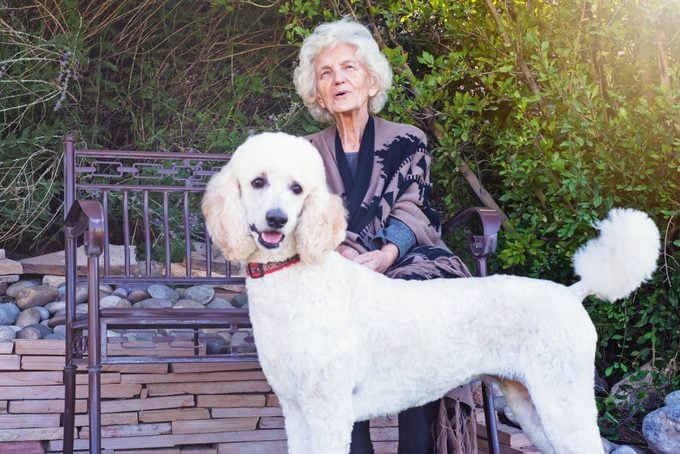
5. Standard poodle
Of the three sizes of poodles, the standard poodle is the largest at around 50 to 60 pounds. If you’ve ever seen a poodle in the show ring, you may think they look too “foo-foo” and self-absorbed to be emotional support dogs. Not a chance—they are actually quite lovey-dovey, eager to please, and easy to be around you 24/7. When it comes to grooming, poodles have hair that grows like humans. “These non-shedding dogs are often goofy and have an uplifting personality, which will surely rub off and brighten your day. They’re also super smart and can usually read their pet parents,” says Ellis. With proper care and nutrition, they’ll be by your side for years to come because poodles are one of the dog breeds that live the longest.
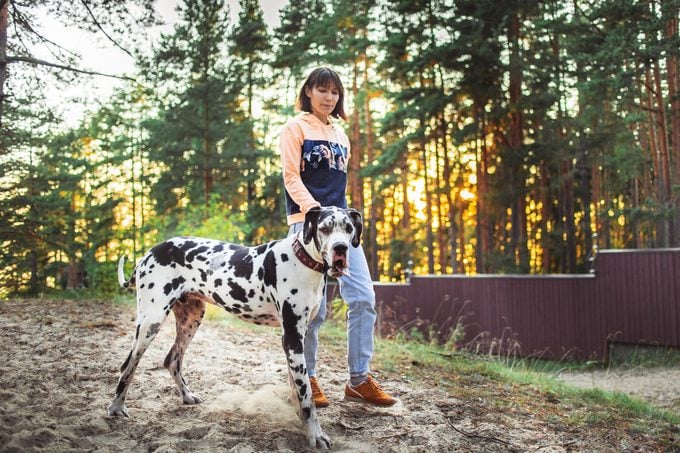
6. Great Dane
The Great Dane makes quite an impression with its towering physique. That may be very appealing for someone who wants a four-legged bodyguard or a buffer zone when interacting with other people. The Great Dane is by no means unfriendly, but as a guard dog breed, their loyalty, protection, and affection lie with you first. They tend to be aloof with people they don’t know, yet incredibly friendly with their human. “I love Great Danes, as they truly are gentle giants. Their affection and compassion is endless, and being so large a good snuggle can help with some deep pressure therapy,” says Ellis.
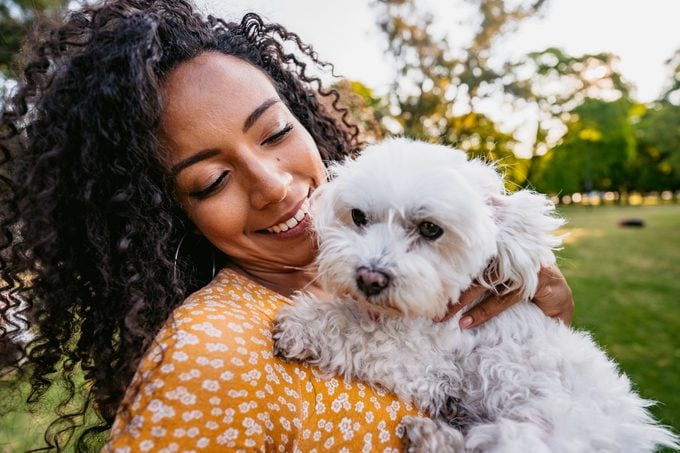
7. Maltese
If you’re looking for a silky white pint-size cuddle bug with big expressive eyes, the Maltese might be the emotional support dog for you. When they’re not cozying up on your lap, they are the life of the party, even if if it’s just a party for the two of you. “The Maltese is a good choice for a single adult, as they tend to have a favorite person that they attach to,” says Dr. Choczynski Johnson. They can’t give therapeutic advice, but they’ll comfort and soothe you with a lick or muzzle snuggle. As an emotional support animal, The Maltese is probably nearby most of the time. Still, keeping them in your sights is a good thing because they’re one of the dog breeds that get stolen the most.
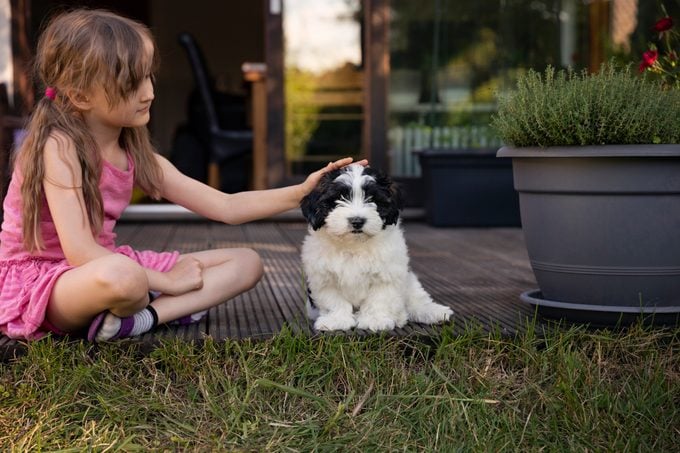
8. Havanese
Looking for a soft and furry travel companion? The Havanese is an adaptable breed that is up for air travel or road trips alike. “Selecting a non-shedding dog that has a calm temperament will be courteous to other travelers and help to set the stage for ongoing airline industry accommodations,” says Dr. Choczynski Johnson. Havanese and other small dog breeds who fit into a carrier can still fly with you when stowed under the airplane seat. Traveling or not, the Havanese is uber friendly, and effortlessly makes friends with everyone they meet, which takes the focus off you.
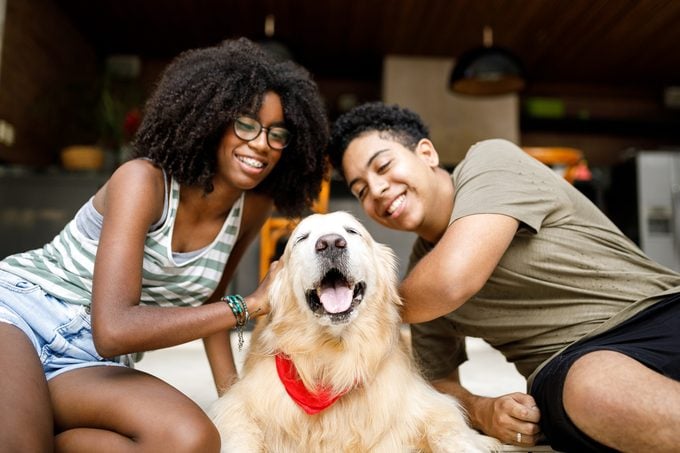
9. Golden retriever
The golden retriever’s number one skill set is loyalty, Dr. Choczynski Johnson. “Their classic cuddle involves a heart-melting heavy chin on the lap and an upward gaze. This form of bonding and emotional support, pair with unbridled enthusiasm when arriving home makes the golden retriever a great candidate,” she says. A routine of feeding, walking, and grooming a dog provides stability. They are excited to see you, but like all dogs, also eager to stretch their legs and get some exercise—and after you take a pleasant stroll together and a few rounds of fetch, the golden will be content to hang out with you.
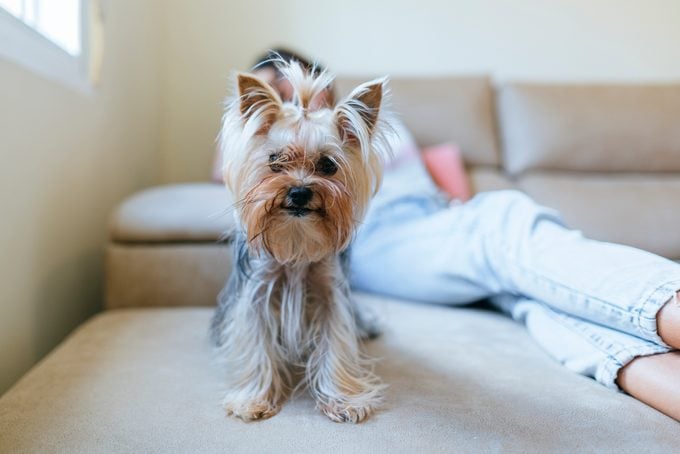
10. Yorkshire terrier
In addition to being one of the cutest lap dogs, the Yorkie is a blue-chip candidate as an emotional support dog for many reasons. For starters, Yorkies are portable. They’re petite puptarts at just five to seven pounds and eight inches tall—perfect for when you need a spunky and confident sidekick to help you navigate social situations that make you feel uneasy. At home, they’re playful, energetic, and oh-so affectionate snugglers. Yorkies aren’t intimidating guard dogs by any means, but by nature, they are very protective of their human. As such, they are first-rate watchdogs and will alert you of anything suspicious with a hearty bark.
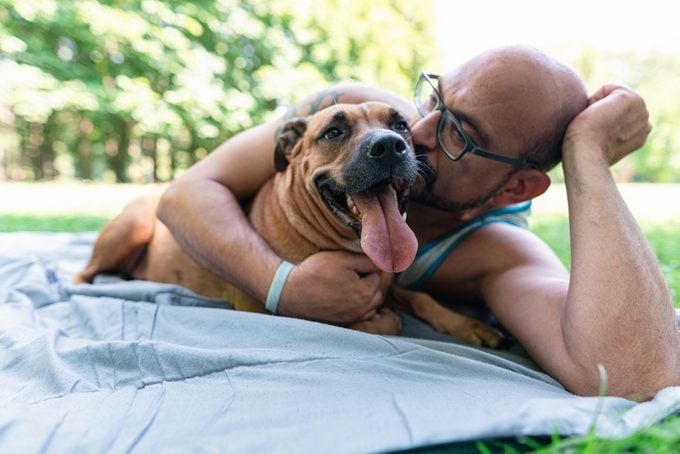
11. Mixed breed
There’s no getting around it. Mixed breed dogs are some of the cutest dogs on the planet and often the best of many breeds. In addition to being adorable, a mixed breed can check all your boxes, whether you want an active dog to get you out of the house or a champion napper for cozy nights in. They all have the potential to be loyal and affectionate. Plus, mixed breeds tend to be the healthiest of many breeds because they come from a wider gene pool and are less prone to hereditary issues. Adopting a dog from a shelter has surprising benefits for you too. “Rescuing a dog can sometimes have even greater meaning emotionally, as many times, after some time has passed, it may feel like they actually rescued you,” says Ellis.
Breeds to avoid
We can’t emphasize this enough—all dogs are individuals. Purebreds, mixed breeds, or rescue dogs all have the capacity to be loving, affectionate, and intuitive, emotional support dogs. That said, some breeds such as the Chow Chow, Boerboel, and Tibetan Mastiff might not be suitable for this role simply because they are naturally independent, dignified, or strong-willed. Other breeds, such as the Australian cattle dog, German Pinscher, or Bergamasco sheepdog are perpetually in “work mode” and hard-wired to be vigilant, fearless, and tenacious watchdogs or herding dogs. And some breeds with a high prey drive, such Kerry blue terrier, Saluki, or rat terrier, could be more interested in chasing a squirrel than consoling you when you’re having a hard day.
How to make your dog an official emotional support animal
You might want your dog to be officially recognized as an emotional support animal to enjoy some legal rights. However, though there are websites that will “register” your dog, there is no official database to register your dog or certification program. To make it official, you must obtain a letter from a licensed mental health professional that clearly states your need for an emotional support animal. You can use your own mental health professional or an emotional support animal service such as ESA Doctors, Emotional Pet Support, or Certapet. These companies can connect you with a mental health pro for the required mental health evaluation needed to get the emotional support animal letter.
What rights do ESA dogs have?
Service dogs are allowed virtually everywhere. However, emotional support dogs don’t receive the same accommodations as service animals. You may already know the U.S. Department of Transportation ruling effective January of 2021 that no longer requires airlines to accommodate emotional support animals. Most major airlines followed suit, but a few airlines, including Volaris and Westjet, still accommodate emotional support dogs. (You can still travel with animals, but they must be stowed in a pet carrier under the seat or in a crate in the cargo area. When it comes to rental housing and campus housing under the Fair Housing Act, a person with a support animal may make an accommodation request so the dog can live in the apartment and/or on-campus and request any pet fees be waived as emotional support animals are technically not classified as pets.
Read on to find out what a yellow ribbon on a dog’s collar really means.
Sources:
- ADA: Service Animals and Emotional Support Animals
- BMC Psychiatry: “The power of support from companion animals for people living with mental health problems: a systematic review and narrative synthesis of the evidence”
- Human Animal Interaction: “Exploring Benefits of Emotional Support Animals (ESAs): A Longitudinal Pilot Study with Adults with Serious Mental Illness (SMI”)
- Angela Logsdon-Hoover, ABCDT, a certified dog trainer and canine behaviorist, and regional technician director with VCA Animal Hospitals.
- Stacy Chocznski Johnson, DVM, and veterinary expert for Pumpkin Pet Insurance
- Nicole Ellis, a certified professional dog trainer, and Pet Lifestyle Expert with Rover
- U.S. Department of Transportation: “Traveling by Air with Service Animals”

